Church and Rectory Residents
Over
the years many clergy and lay people have lived in the church flats
and/or the Rectory; some of them made significant contributions to the
wider church and community. Here
are details of some of them.
Denys Munby
Denys Lawrence
Munby (1919-76) was a conscientious objector of the Second World War
period. A student at Oxford, he joined a small group of Oxbridge
undergraduates who in 1940 (at the height of the Battle of Britain)
formed a Universities Ambulance Unit (UAU) and started medical training
at a camp at Hawkspur Green, near Little Bardfield in Essex, formerly
the site of an experiment to reform delinquent boys. It was something
of an intellectual powerhouse; in the evenings, they organised play
readings and drank in the local pub (where they were suspected of being
nudists rather than COs). When their training was completed, some
signed up for the Friends Ambulance Unit, though others, believing
their pacifist utopia had failed, enlisted in the armed forces. More detail in
chapter 23 of Peter Brock Against the Draft (University of Toronto Press
2006).
Denys had been influenced by the League of the Kingdom of God, aka Christendom Group, of V.A. Demant and others, but together with his friend Ronald Preston (the first
academic theologian with an LSE degree in economics - and
incidentally a former colleague of the present Rector of St
George-in-the-East) became critical of its amateurism on social ethics.
Technical competence was needed, and attention to the 'facts of the
case'. Preston had introduced him to Archbishop William Temple's view
(adumbrated in his 1942 Penguin Special Christianity and Social
Order) that, while Christians may rightly disagree on specific
policies, which depend on expert political and economic judgement,
about which (in Munby's words) a Christian as such has no more reliable judgement than an
atheist, the church's task is to spell out broad biblical principles -
later termed 'middle axioms'. This approach has been much-debated, but
Munby was one of those committed to spelling out what this might mean.
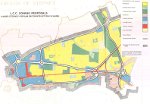
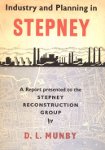 In this spirit,
painstaking attention to detail was to mark his academic career. His
report to the Stepney Reconstruction Group, Industry and Planning in
Stepney
(OUP 1951), epitomised this: it is full of facts, figures,
charts and maps of all the local trades and industries. (The map
showing the LCC zoning proposals for the reconstruction of Stepney and
Poplar is shown on the right.) It was
dedicated to all those who were at Christ Church and St George's
1940-2 and particularly Father John [Groser]
- who had made submissions to the group. He had lived in the Rectory in
the 1940s, together with another Denys (Giddey) - their rations in the
kitchen were carefully marked 'Denys M' and 'Denys G' - and retained
great affection for the parish.
In this spirit,
painstaking attention to detail was to mark his academic career. His
report to the Stepney Reconstruction Group, Industry and Planning in
Stepney
(OUP 1951), epitomised this: it is full of facts, figures,
charts and maps of all the local trades and industries. (The map
showing the LCC zoning proposals for the reconstruction of Stepney and
Poplar is shown on the right.) It was
dedicated to all those who were at Christ Church and St George's
1940-2 and particularly Father John [Groser]
- who had made submissions to the group. He had lived in the Rectory in
the 1940s, together with another Denys (Giddey) - their rations in the
kitchen were carefully marked 'Denys M' and 'Denys G' - and retained
great affection for the parish.
With his wife
Mary (also an economics graduate) he went to Scotland, where he became
Lecurer in Political Economy at Aberdeen University. (One of his grateful students there was Madeleine Simms
née Zimmermann (1930-2011), who was a schoolfriend of Gillian Groser,
whose father she impressed and amused on a visit to the Rectory with
her detailed knowledge of archbishops though she was a secular Jew; she
became a rights campaigner). In 1958 he was
appointed as the first Reader in
transport economics and professorial fellow at Nuffield College,
Oxford, and a stream of technical publications followed; he was co-founder of the Journal of Transport Economics and Policy, and advised on the Channel Tunnel project, and the modernisation of British Railways. He aimed to be
a realist. Among his typically trenchant comments, made to the Select
Committee on Nationalised Industries in 1968, was Only the
psychologically disturbed or inadequate want transport for its own
sake. He objected to the head of London Transport's claim that he had
a kind of 'social contract' with Londoners - this made no social or
economic sense.
More recent history has called this judgement into
question: without such a commitment Londoners are vulnerable.
Another 'mercurial' comment, in relation to a scheme for an Oxford ring
road that would have compromised Christ Church meadows, was there has never really been any conflict between peace in the High and peace in the Meadow.
He continued
to write on wider themes in Christian social ethics. In Christianity
and Economic Problems (Macmillan 1956) he had affirmed his commitment to the
incarnational theology of F.D. Maurice and his followers, but lamented
the economic naïveté of contemporary commentators. Private enterprise
and the profit motive were not all bad, he said; the price mechanism
was the only way in which a large-scale economic system can satisfy
the needs of a large population. The state was neither all-wise nor
all-good. However, in God and the Rich Society (OUP 1961) he cautioned
against giving too much weight to the views of economic 'experts',
pointing out that they too had presuppositions. In The Idea of a
Secular Society: and its Significance for Christians (OUP 1963) - based on
his Riddell Memorial Lectures of the previous year - he poured scorn on
the gullibility of Anglican thinkers, such as Victor Demant and Maurice
Reckitt, in embracing 'absurd' theories such as social credit. T.S.
Eliot's Idea of A Christian Society (1939) was, in his view, ultimately
romantic escapism. 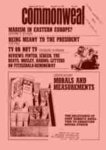 He was explictly critical of the Christendom Group's
failure to address issues of plurality and tolerance, and espoused a
'secularist' approach - seeing God active in the whole of society and
in all human enquiry, not just in religious enclaves. This enabled
Christians to welcome diversity, and to engage with a wider range of
traditions. This rational, liberal view was very much of its time, but
subsequent thinking has exposed its weaknesses. Munby's position, that 'secularism' is the only way to embrace plurality, is
discussed further in 'Plurality and contemporary British Christian ethics', ch.5 of Ian S. Markham Plurality and Christian Ethics
(Cambridge University Press 1994), which also considers Ronald
Preston's stance (which is less concerned with plurality). In 1971 he
wrote a short article in the radical Catholic journal Commonweal on 'Morals and Measurement'.
He was explictly critical of the Christendom Group's
failure to address issues of plurality and tolerance, and espoused a
'secularist' approach - seeing God active in the whole of society and
in all human enquiry, not just in religious enclaves. This enabled
Christians to welcome diversity, and to engage with a wider range of
traditions. This rational, liberal view was very much of its time, but
subsequent thinking has exposed its weaknesses. Munby's position, that 'secularism' is the only way to embrace plurality, is
discussed further in 'Plurality and contemporary British Christian ethics', ch.5 of Ian S. Markham Plurality and Christian Ethics
(Cambridge University Press 1994), which also considers Ronald
Preston's stance (which is less concerned with plurality). In 1971 he
wrote a short article in the radical Catholic journal Commonweal on 'Morals and Measurement'.
Denys Munby died
suddenly in Istanbul in 1976, during an archaeological expedition.
Mary continued to work in the Department of Psychiatry at Oxford, publishing studies on behavioural therapy and agoraphobia. Professor
Ronald Preston continued to explore the approach to social and economic
ethics that he shared with Denys in his many publications, including Religion and the Persistence of Capitalism (SCM 1979) until his own death in
2001.
Andrew Quicke, Richard Ford, Leo Aylen
Andrew (now a professor of film studies,
with special expertise in 'redemptive' cinema) and Richard were among
the many top-floor residents of the Rectory in the 1960s, drawn into
parish activities; the actor, playwright and poet Leo Aylen stayed regularly with them, and often played piano and (when the new church was created) organ
for services. Born in what is now KwaZulu (a former bantustan of South
Africa), where his father was elected Bishop of Zululand, Leo read
Classics at Oxford (later completing a doctorate on Greek theatre at
Bristol), where he was a keen runner, climber and pianist. He reflects here on his connections with the parish, including his play George.
Marguerite Stone
was an actress
who lived in the basement of the Rectory in the 1970s (at a rent of £5
per week, plus a contribution to rates). From 1954-57 she had played the lead role of Molly Ralston in The Mousetrap,
taking over from Sheila Sim. When three others - Joan Harvey, Heather
Stannard and Mary Law - had followed her, celebrations of the play's
long run were held; but in the years since then there have been several
times that number. In 1970 she was signed up for George Englund's
curious film Zachariah - loosely based on Hermann Hesse's Siddhartha adapted as a kind of musical Western - but in the event did not appear in it.
Alan Shadwick
Alan was from a
working-class background in Lancashire. His father died in the First
World War, and Alan was a registered conscientious objector, spending
these years looking after pigs near Cambridge, where he was a student.
He became a journalist, writing for various newspapers. He remained a
committed pacifist, and in due course a supporter of the Jubilee Group
of Christian Socialists. Friends remembered him for his intellectual
curiosity, and for shared jokes (which often centred on Cambridge life).
In 1949 be became news editor of the Church Times,
and three years later its assistant editor until his death on 14 April 1973. He wrote its
gossip column, initially lumbered with the pseudonym 'Squirrel Nutkin'
but then taking the name 'Pennyfields' (a street off the West India
Dock Road, now close to Westferry DLR station). An early and typical
piece described his visit, shortly before his death, to Fr Leighton
Sandys Wason
(1867-1950), an eccentric and extreme anglo-papalist priest who was
living in penury in rooms on the East India Dock Road, attached to the
former church of St Peter Limehouse (a far cry from the contemporary
style of Limehouse religion); you can read part of his account
in Roy Tricker Mr Wason....I think (Gracewing 1995).
For most of
Alan's time at Church Times, all its writers were expected to maintain
the paper's inherited anglo-catholic stance - Monica Furlong, for instance,
alleged that she was denied a job because she could not distinguish
between a cope and a chasuble. Alan's pamphlet The Way of Christ,
published in 1961 for the Church Literature Association, reflects this
position. The paper condemned Bishop John Robinson's Honest to God in
1963, and other aspects of what became known as 'South Bank religion'
in the diocese of Southwark. When Alan went to interview a deaconess in
Camberwell, she greeted him with the words Yes, you're in the heart of
the enemy country here! On another occasion, a priest in the
diocese told him The Church Times - that's anathema to us younger
clergy. But the paper's policy was to change, and broaden, and Alan's influence was part of this process.
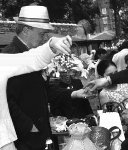
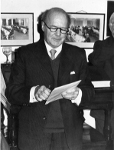 It was during
his latter years at the Church Times
(to whom we are grateful for this picture, from their achives) that he
came to live here, first
in one of the new flats in church and later on the first floor of the
Rectory, and became
part of the parish community, serving for a time as churchwarden. The
other picture shows him on duty at a
church fair. He felt he belonged here: after his death, his ashes were
interred in the Rectory garden, below a 2002 2p piece set into the top
of the curved wall to the NW corner of the church.
It was during
his latter years at the Church Times
(to whom we are grateful for this picture, from their achives) that he
came to live here, first
in one of the new flats in church and later on the first floor of the
Rectory, and became
part of the parish community, serving for a time as churchwarden. The
other picture shows him on duty at a
church fair. He felt he belonged here: after his death, his ashes were
interred in the Rectory garden, below a 2002 2p piece set into the top
of the curved wall to the NW corner of the church.
Alan was a
devotee of Frank Richards' Billy Bunter stories, writing occasionally
about them; in 1957 he produced an exercise 'Greyfriars for Ever' for
Harry Bayley's Quicker Reading (Pitman 1971 - an early manual on what is now called 'speed reading'). He was also a
lifelong friend of Martin à Beckett Boyd (1893-1972), novelist
and painter who was raised in Australia but lived most of his life in
Europe (and died in mysterious circumstances in Rome). Alan met him at
a pacifist meeting for conscientious objectors, and they later shared
holidays in Europe. In a taped interview
of 1977 (held at the
National Library of Australia), they discuss pacifism, spirituality
(including Evensong at King's College Cambridge) and politics; Boyd's
autobiography Day of My Delight (Lansdowne Press 1965) - the title a quote from John Bunyan - refers to their
friendship.
Edward Whitehorn
The Revd Edward Harold Whitehorn (1907-??) studied history at King's
College Cambridge and trained for ordination at Cuddesdon. He served
curacies in Clapham, Newcastle and Wallsend, but after some
'difficulties' left parochial ministry and became publicity manager for The Society for Promoting Christian Knowledge
(SPCK) in 1949 until his retirement in 1971, living latterly in the
Rectory (leaving after further 'difficulties'). SPCK is the oldest Anglican missionary society, involved in
distributing and publishing books and creating libraries; in
Whitehorn's time its headquarters were at Holy Trinity Church,
Marylebone. Although its bookshops are now gone (following much
controversy in 2006) it continues to publish, and provide worldwide
study literature.
Marcus Cook
The
Revd Marcus John Wyeth Cook trained at Chichester and was a curate in
Friern Barnet; from 1973 to 2013 he lived in one of the church flats,
and
was an honorary curate in the parish until 2000, working in secular
employment and latterly doing gardening work for friends and
acquaintances - and maintaining the colourful tubs around the church
steps, and the shrubs along the driveway. When anyone was sick, he was
always among the first to visit. He moved in 2013 to sheltered
accommodation in Bow.
Back
to Clergy 1900-
| Back to Rectory



 In this spirit,
painstaking attention to detail was to mark his academic career. His
report to the Stepney Reconstruction Group, Industry and Planning in
Stepney
(OUP 1951), epitomised this: it is full of facts, figures,
charts and maps of all the local trades and industries. (The map
showing the LCC zoning proposals for the reconstruction of Stepney and
Poplar is shown on the right.) It was
dedicated to all those who were at Christ Church and St George's
1940-2 and particularly Father John [Groser]
- who had made submissions to the group. He had lived in the Rectory in
the 1940s, together with another Denys (Giddey) - their rations in the
kitchen were carefully marked 'Denys M' and 'Denys G' - and retained
great affection for the parish.
In this spirit,
painstaking attention to detail was to mark his academic career. His
report to the Stepney Reconstruction Group, Industry and Planning in
Stepney
(OUP 1951), epitomised this: it is full of facts, figures,
charts and maps of all the local trades and industries. (The map
showing the LCC zoning proposals for the reconstruction of Stepney and
Poplar is shown on the right.) It was
dedicated to all those who were at Christ Church and St George's
1940-2 and particularly Father John [Groser]
- who had made submissions to the group. He had lived in the Rectory in
the 1940s, together with another Denys (Giddey) - their rations in the
kitchen were carefully marked 'Denys M' and 'Denys G' - and retained
great affection for the parish.  He was explictly critical of the Christendom Group's
failure to address issues of plurality and tolerance, and espoused a
'secularist' approach - seeing God active in the whole of society and
in all human enquiry, not just in religious enclaves. This enabled
Christians to welcome diversity, and to engage with a wider range of
traditions. This rational, liberal view was very much of its time, but
subsequent thinking has exposed its weaknesses. Munby's position, that 'secularism' is the only way to embrace plurality, is
discussed further in 'Plurality and contemporary British Christian ethics', ch.5 of Ian S. Markham Plurality and Christian Ethics
(Cambridge University Press 1994), which also considers Ronald
Preston's stance (which is less concerned with plurality). In 1971 he
wrote a short article in the radical Catholic journal Commonweal on 'Morals and Measurement'.
He was explictly critical of the Christendom Group's
failure to address issues of plurality and tolerance, and espoused a
'secularist' approach - seeing God active in the whole of society and
in all human enquiry, not just in religious enclaves. This enabled
Christians to welcome diversity, and to engage with a wider range of
traditions. This rational, liberal view was very much of its time, but
subsequent thinking has exposed its weaknesses. Munby's position, that 'secularism' is the only way to embrace plurality, is
discussed further in 'Plurality and contemporary British Christian ethics', ch.5 of Ian S. Markham Plurality and Christian Ethics
(Cambridge University Press 1994), which also considers Ronald
Preston's stance (which is less concerned with plurality). In 1971 he
wrote a short article in the radical Catholic journal Commonweal on 'Morals and Measurement'. 
 It was during
his latter years at the Church Times
(to whom we are grateful for this picture, from their achives) that he
came to live here, first
in one of the new flats in church and later on the first floor of the
Rectory, and became
part of the parish community, serving for a time as churchwarden. The
other picture shows him on duty at a
church fair. He felt he belonged here: after his death, his ashes were
interred in the Rectory garden, below a 2002 2p piece set into the top
of the curved wall to the NW corner of the church.
It was during
his latter years at the Church Times
(to whom we are grateful for this picture, from their achives) that he
came to live here, first
in one of the new flats in church and later on the first floor of the
Rectory, and became
part of the parish community, serving for a time as churchwarden. The
other picture shows him on duty at a
church fair. He felt he belonged here: after his death, his ashes were
interred in the Rectory garden, below a 2002 2p piece set into the top
of the curved wall to the NW corner of the church.